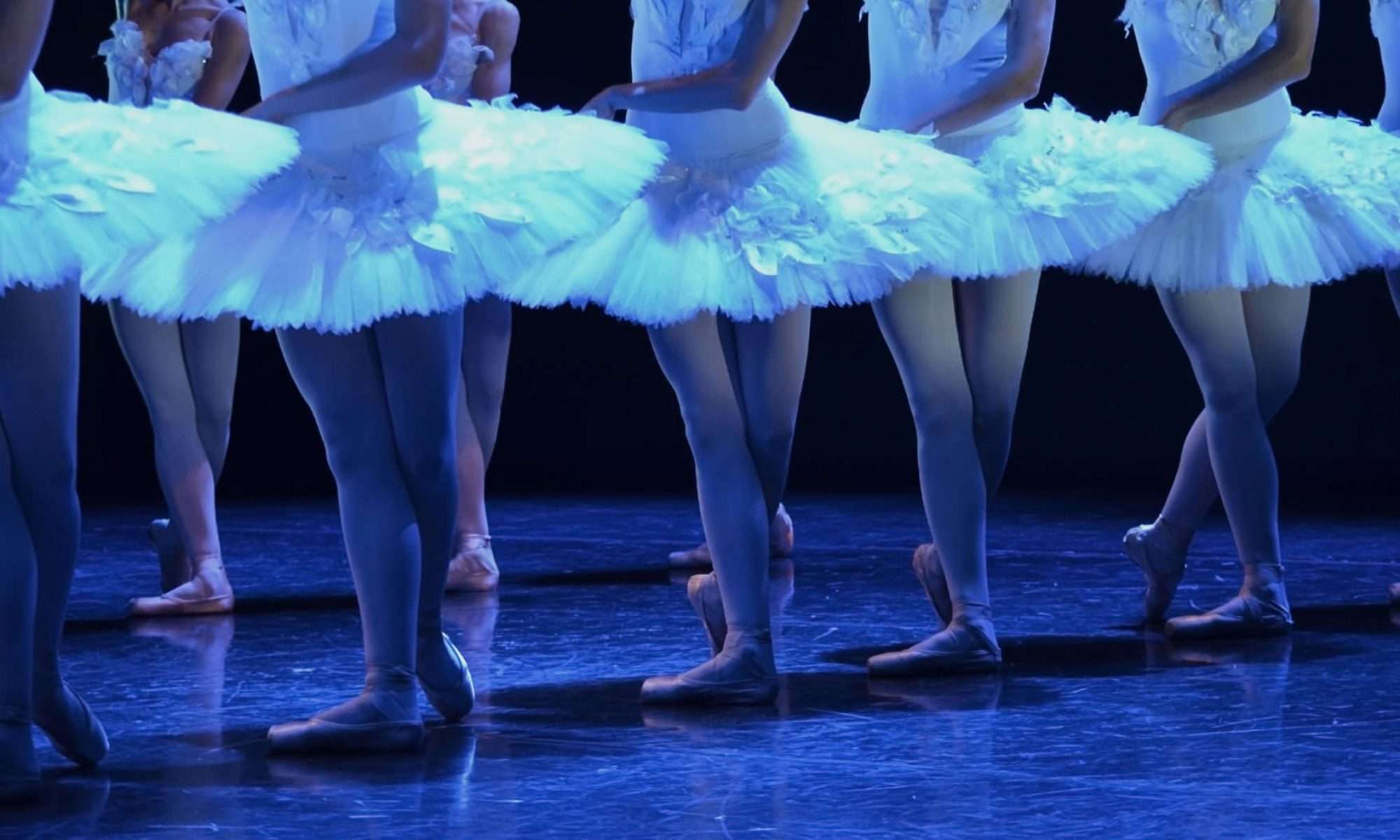Ballet class with children ages 3-5 is often called “creative movement” rather than ballet class. Then at age 6 it is sometimes referred to as “pre-ballet”, which is when they are usually ready to stand at the barre and learn the mechanics of alignment and ballet positions. Creative movement can be taught many different ways—none better or more effective than another—so I will just share some of the things I did with this age group (and felt were effective) when I was teaching them dance.
First of all, kids this age don’t have a very long attention span! Two minutes is about as long as you can stretch one activity before moving on to something else. I always felt that a 45 minute class was the absolute longest these kids could handle, unless you are combining it with some tap, too. I’d also say that if you have more than eight children in the class then you should probably have an assistant there to help you out.
Begin sitting in a circle — stretching and singing
I structured my creative movement classes more or less the same way each week. Kids do like repetition and it helps them feel more comfortable if they have a good idea what to expect. We would begin sitting on the floor in a circle, wide enough that when they put their arms out to the sides they wouldn’t touch their neighbor. At the beginning you can have them sit cross legged or with the soles of their feet together or their legs stretched out straight in front of them. Sitting cross legged is easiest for them, and when you want them to focus attention on sitting up straight and using good posture through their backs, necks long, and shoulders down, this is helpful.
Still in the circle we would also sing a lot. There are several songs that some children may already know or can pick up quickly that you can easily add movements to. I liked “Open, Shut Them”. You sing Open, Shut Them, Open, Shut Them, Give a little clap clap clap, Open, Shut Them, Open Shut Them, Put them in your lap lap lap. You can do variations on this using your hands like in prayer position or using your legs to open to a straddle and close legs together straight in front of you. Then you can sing Creep Them, Creep Them, Creep Them, Creep Them Right down to your toes (crawling with fingers down outstretched legs in front and toward their toes) and repeat Creep Them, Creep Them, Creep Them, Creep Them, Right back to your nose.
In the circle you can also work on flexing and pointing the toes and flying like a butterfly using pretty arms with the soles of the feet together. They also enjoyed lying on their bellies with their heads towards the center of the circle, practicing pushing up onto their hands and keeping their necks long (like a cobra in yoga), and lifting their heads and their feet off the ground and flying like Superman.
Play rhythmic games and get them moving in the center
Practicing little rhythmic patterns is a fun thing to do in the circle as well. You can have them help you make up four count or eight count phrases such as clap hands 2X, clap hands to knees 2X, clap hands to shoulders 2X, and put both hands on your head, hold count 8. You can repeat with only one clap in each position, etc. Adding head movements and even facial expressions is a great way to interact with them and get them working on putting together patterns.
In the center there are many activities you can do with this age group. Props are fun, too, especially if you have colorful scarves they can improvise with at the end of class. I tried to incorporate learning how to hop on one foot, gallop, skip, walk toe to heel across the floor like on a tightrope, and eventually even learning a small polka step on demi pointe and plié (step R, L on demi pointe, step R in plié, repeat LRL across the floor). You can reverse that polka, too, and do down, up, up…down, up, up. It’s amazing what children this age can pick up. When you feel like you’re losing them, go back to imitating an animal to get their attention again. Take light springy steps like a cat, heavy steps like a gorilla, etc.
End class with something fun that they’ll look forward to every class
At the end of class we’d always put a scarf or something down in the center that they could run and jump over one at a time. The idea would be to leap leading with their right leg the first time, and then starting at the other upstage diagonal leap leading with their left leg, but usually you are lucky if they manage to just leap and land on one leg instead of two. It’s a really fun age to teach. I think when I was teaching this level I was too worried about getting enough “technique” into each class. But really, having them move to music and count out rhythms and learn patterns is truly enough. At this stage it’s most important that they enjoy what they are doing.
Maybe other teachers of creative movement have more to add. And I think that never having danced at this age myself, it’s harder for me to say exactly what’s so important about it and what’s not. I don’t think it can make or break a dancer, unless you become too exacting and they tire of it before it’s really time to begin working on technique. Please share your thoughts!



Great post! I am a creative movement teacher and I enjoyed reading your ideas. For this age I use a magic elevator and travel to different places to explore. Pretend like you are in an actual elevator I ask them to give me a number to the floor and then we push the button and ride up to that floor. We go to places such as under the sea, the toy shop, the forest, etc. The possibilities are endless! It’s so fun and they love it! For my creative ballet classes I infuse the ballet… but I take most of the ideas from them. They are just like little sponges!
I hope you check out and follow my blog! I post for dance educators. 🙂
That’s a great idea! You can use plie and releve with the elevator concept, too. Thanks! I’ll check out your blog today.
I really enjoyed this article. I passed it along to a few would-be teachers I’ve had inquiries from, regarding teaching smaller children. Thanks!
Thanks, Dianne!
This is a great article. I teach preschool ballet and mommy and me ballet in SC. I love working with this age. You have posted a some great ideas. I made up a song/rhyme to introduce basic ballet terms to my toddlers and pre ballerinas. You can check it out at my mommy and me blog at http://www.mommyandmeballet.blogspot.com. I look forward to keeping up with your blog/site.
This is pretty much the program I have used for the last 35 years and it is very successful for the little ones. This is testimony that it really works to all who do not use these ideas!
This was so incredibly helpful. I start teaching tots very soon, and you gave me lots of great ideas! Thank you do much.
That’s great to hear, Lauren. You’ll love working with this imaginative and energetic age group!
Hello!
I am teaching a dance class for 3 to 5-year-olds and I am new to teaching dance. I am having such a hard time getting them to have fun and also listen! Even waiting for their turns when doing across the floor work. Please help me!
It is a challenge! When it was up to me I always said the kids had to be at least 4 years old. You have to go from one activity to another pretty quickly to keep their attention. Asking them questions can be helpful when trying to keep them engaged, or having them take turns selecting an animal to imitate, etc. You may not feel like anything is sinking in with them because you go through things so quickly, but kids love repetition and week after week it does begin to sink in and you can then build on the skills they’ve learned. It takes a lot of patience. Another thing I learned with children is that if you speak too loudly to get their attention they’ll just get louder too. When you whisper or talk very softly, they will quiet down so they can hear you. Using props like scarves keeps their interest in an activity for a bit longer, too. Good luck, and I hope that helps!
Instead of having them go across the floor one at a time perhaps you can have them go straight across the floor (instead of diagonally) three or four at a time.
Thank you Tammy! Please give me any more tips. I feel like I may be making this too challenging for them and so they are getting frustrated instead of having fun with it.
What is your class format that you do each week? What do you have them do with the scarves?
We sometimes put the scarves in a pile to leap over, and then they’d each get one to improvise with. I always did that last, sort of like a reward for listening and working with me up until then. I haven’t taught this age group in years, but remember using a lot of make-believe. When we sat in the circle I’d talk about pretty bracelets that we’d pretend to put on and then we’d move our arms in port de bras to show them off. We’d put a pretend glass of water on our heads and then move our heads carefully from side to side. Kids love to pretend, so whenever you can “disguise” learning with play, you’ll be great!
Do you have any good suggestions of music to use for children between 3-4yrs?
I am looking for a fun and engaging playlist or album to use when teaching 3-4 year olds creative movement class . Do you have any suggestions?